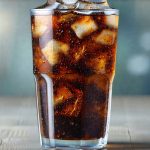The sensation of fullness, bloating, or even discomfort after a meal isn’t always about what you ate, but also how you consumed it. Often overlooked, the fluids we drink with meals play a surprisingly significant role in digestive comfort and overall gastrointestinal pressure. Many people intuitively reach for large glasses of water, juice, or soda alongside their food, believing it aids digestion. However, this practice can inadvertently contribute to feelings of fullness, bloating, and even indigestion for some individuals. Understanding the relationship between fluid intake and digestive function allows us to make informed choices that promote a more comfortable eating experience. This isn’t about eliminating fluids entirely; it’s about strategic pairing – choosing the right types of beverages and timing their consumption to minimize pressure and optimize digestion.
The key lies in recognizing that our digestive system needs space to work effectively. Introducing large volumes of liquid during a meal can dilute digestive enzymes, potentially slowing down the breakdown of food and leading to fermentation or gas production. Furthermore, the physical space occupied by fluids contributes to stomach distension, which triggers signals of fullness even before the body has fully registered satiety from the solid foods consumed. This isn’t a one-size-fits-all situation; individual tolerances vary greatly depending on factors like metabolism, eating habits, and overall gut health. But mindful fluid pairing can significantly improve digestive comfort for many people.
The Science of Digestion & Fluid Volume
Digestion is a complex process that relies heavily on enzymatic activity and mechanical churning within the gastrointestinal tract. The stomach, with its muscular walls, needs to effectively mix food with gastric juices containing enzymes like pepsin to initiate protein breakdown. This mixing action requires space for optimal function. When large amounts of fluid are introduced simultaneously, it increases the overall volume in the stomach, reducing the efficiency of this mechanical process and potentially diluting the concentration of digestive enzymes. Imagine trying to knead dough in a bowl that’s already overflowing – it becomes much harder to work with!
The impact isn’t limited to the stomach. As partially digested food moves into the small intestine, the continued presence of excess fluids can overwhelm the absorptive capacity of the intestinal walls. This leads to increased transit time and potentially contributes to bloating and gas as undigested carbohydrates ferment in the lower digestive tract. It’s a cascading effect; initial fluid overload in the stomach impacts processes further down the line. Proper hydration is crucial, but timing and type are paramount – often, sipping fluids between meals rather than during them can be more beneficial for minimizing pressure.
Furthermore, different types of fluids have varying effects on digestion. Sugary drinks, for instance, can exacerbate bloating due to their rapid fermentation by gut bacteria. Carbonated beverages introduce additional gas into the digestive system, further contributing to distension and discomfort. Conversely, water is generally well-tolerated, but even its quantity needs consideration during a meal.
Optimizing Fluid Intake Around Meals
The goal isn’t to eliminate fluids with meals entirely, but rather to optimize their timing and quantity. Here’s how:
- Pre-Meal Hydration: Drink the majority of your daily fluid intake between meals. This ensures you are adequately hydrated without overloading the digestive system during eating. Aim for 16-24 ounces of water throughout the day, spread out evenly.
- Small Sips During Meals: If you prefer to drink something with your meal, limit yourself to small sips (around 4-8 ounces) rather than large glasses. This minimizes dilution and stomach distension.
- Choose Wisely: Opt for water as the primary beverage during meals. Avoid sugary drinks, carbonated beverages, and excessive amounts of juice. Herbal teas can be a good alternative for some individuals, but pay attention to how your body responds.
The Role of Temperature in Fluid Pairing
The temperature of fluids can also influence digestive comfort. Extremely cold liquids may constrict blood vessels in the stomach, potentially hindering digestion. This is because the body diverts energy towards warming the liquid rather than focusing on food processing. Conversely, excessively hot beverages can irritate the esophagus and stomach lining, leading to discomfort.
Room temperature or slightly warm fluids are generally better tolerated. They require less metabolic effort from the body and are less likely to disrupt digestive processes. Think about it like this: your body functions best at a stable internal temperature. Introducing extreme temperatures requires more energy expenditure, potentially impacting digestion. Consider warming your water slightly, especially during colder months, or allowing iced beverages to warm up a bit before consuming them with meals.
Identifying Individual Sensitivities
Everyone’s digestive system is unique, and what works for one person may not work for another. Pay attention to your body’s signals. If you consistently experience bloating, gas, or discomfort after eating, experiment with different fluid pairing strategies.
- Keep a food diary: Note what you ate, how much fluid you drank, and any symptoms you experienced.
- Eliminate trigger beverages: Temporarily remove sugary drinks, carbonated beverages, and large amounts of juice from your diet to see if it improves your digestive comfort.
- Adjust timing: Experiment with drinking fluids before, during, or after meals to determine what works best for you.
- Seek professional guidance: If you have persistent digestive issues, consult a registered dietitian or healthcare provider to rule out any underlying medical conditions and receive personalized recommendations. This information is not intended as a substitute for professional medical advice.
Ultimately, reducing pressure during meals isn’t about adhering to strict rules; it’s about cultivating mindful awareness of your body’s needs and making informed choices that support optimal digestive function. It’s about recognizing the interconnectedness between fluid intake and overall gastrointestinal comfort, allowing you to enjoy your meals without discomfort or distress.





















